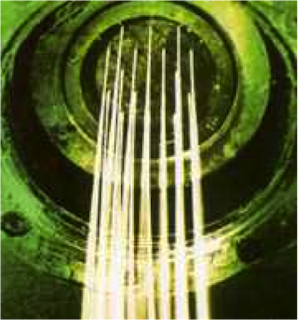Man Made Fibers
 |
| spinneret |
Man made Fiber can Be divided into two
groups. First is Natural Based man made fiber such as Rayon, Acetate, And
Lyocel. Second are fully synthetic fibers, which are made in fiber making mill
from chemical solutions passed through a device, called spinneret to form the
fiber strand.
All man-made fibers are in filament. But,
in blended fabrics, short fiber of man-made fiber is needed. Short man made
fiber is produced by cutting the long filament during the production. For example
: polyester very often blends with cotton or rayon in order to get specified
b;ended fiber properties.
There are some popular full synthetic fiber
have been using for production of textile fabric such as polyester, polyamide
(nylon), acrylic, and spandex.
To get special properties of textile from
some different fibers, the fabric mills do make blended fabric such as
polyester/cotton, polyester/nylon, polyester/rayon, polyester/nylon/cotton,
polyester/acrylic, wool/acrylic, cotton/spandex, nylon/spandex, etc.
|
Properties
|
Acetate
|
Viscose Rayon
|
Acrylic
|
Nylon
|
Polyesters
|
Spandex
|
|
Abration Resistance
|
Poor
|
Fair
|
Fair
|
Excellent
|
Good
|
Good
|
|
Absorbancy (% M.R)
|
6.5 %
|
11%
|
1.5%
|
2.8 -4.8 %
|
0.4 %
|
1%
|
|
Flexibility
|
Excellent
|
Good
|
Good
|
Good
|
Fair
|
Good
|
|
Hand Feel
|
Excellent
|
Good
|
Good
|
Fair
|
Fair
|
Poor
|
|
Pilling Resistance
|
Good
|
Good
|
Fair
|
Poor
|
Very Poor
|
Excellent
|
|
Strength dry (g/denier)
|
1.2 -1.5
|
1.2 – 3.0
|
2.0 -3.5
|
2.5 – 7.3
|
3.0 -6.0
|
0.7 – 1.0
|
|
|
Poor
|
Poor – Good
|
Fair
|
Excellent
|
Excellent
|
Very poor
|
|
Strength when wet
|
30%
|
30% - 50%
|
20%
|
0
|
0
|
0
|
|
% Elongation at break
|
25 -45
|
15 -30
|
35 – 45
|
16 -75
|
30 – 100
|
19 -55
|
|
% Recovery from 2 % strain
|
48 – 65
|
95
|
92
|
82 -100
|
81
|
99
|
|
Mildew resistance
|
Excellent
|
Fair
|
Excellent
|
Excellent
|
Excellent
|
Excellent
|
|
Renovation (Wash or DC)
|
DC
|
W or WC
|
W or DC
|
W or DC
|
W or DC
|
W or DC
|
|
Safe iron limit (ºC)
|
160
|
175
|
150
|
175
|
160
|
150
|
|
|
|
|
|
|
|
|
Based on the above properties of fibers,
then the end uses of each fiber can showed as below
|
Fiber
|
End Uses
|
|
Cotton
|
Blouses, Pants, Jackets, Towels,
Carpets, Curtains, T-shirt, Belts, And Sneakers
|
|
Flax
|
Dreses, suits, sport jackets, and
luxury table cloths, napkins
|
|
Silk
|
Dresses, scalves, blouses, and other
apparel,. Some silk are used in household, furnishings, particularly,
decorative pillows
|
|
Wool
|
Overcoats, suits, sweaters, carpets
and felt fabric
|
|
Jute
|
Burlap fabric for bagging, fabric for
interior furnishing, carpet backing, cordage
|
|
Ramie
|
Blouses, pants, lingerie, backing
fabric for bonding materials, and cigarette-filter material
|
|
Acetate
|
Lining fabric, lingerie, backing
fabric for bonding material, and cigarette filter material
|
|
Acrylic
|
Sweater, blankets, carpeting, children’s
garment, outdoor product such as bunting and canopies
|
|
Lyocell
|
Apparel, interior furniching, and
industrial product
|
|
Nylon
|
Lingerie, swimwear, exercise wear,
hosiery, jackets, tents, fish nets, sleping bags, rope and luggage
|
|
Olefin
|
Athletic clothes, exercise suits,
underwear, carpet face yarn, upholstery, filter
|
|
Polyester
|
Cloth, bagging, cordage, geotextiles
|
|
Rayon
|
Dreses, shirts, lingerie, jackets,
draperis, medical product, nonwoven fabric, hygine products.
|
|
Spandex
|
Under garments, ski pants, swimwear,
athletic apparel and article where stretch is required
|
|
Microfiber
|
Blouses, slacks, tailored suits,
lingerie, dresses, raincoats, upholstery, sheeting, non woven, and industrial
products
|
|
Metallic
|
Draperies, tablecloths, dresses,
sweater, swimwear, shoes, accessories, ribbons, socks and carpets
|
|
Modacrylic
|
Fur-like fabric, wigs, children
sleepwear, fleece fabric for stuff animal, upholstery, and drapery, and
industrial fabrics.
|





